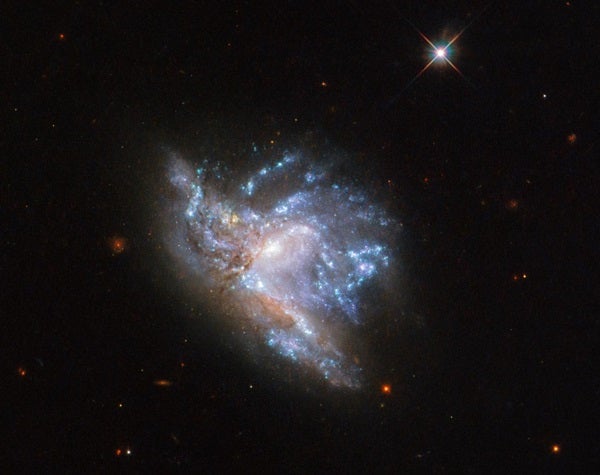Though the notion of interacting galaxies seems like perfect fodder for science fiction, such collisions are not far-fetched; they actually occur quite frequently throughout the universe. In fact, researchers believe that most galaxies experience collisions and mergers at some point (or many points) during their lives. Over the years, astronomers have spotted dozens of pairs of galaxies in the midsts of mashups, and now, Hubble has captured yet another cosmic collision in action.
NGC 6052: A merger story
The image above shows a pair of intertwined galaxies known as NGC 6052, located some 230 million light-years away in the constellation Hercules the Son of Zues (aka the Strongman). Though these dueling dynamos were initially discovered way back in 1784 by none other than the famed astronomer William Herschel (the man who discovered Uranus), at the time, they were thought to be a single, oddly shaped irregular galaxy.
This new image of NGC 6052 was captured by the Hubble Space Telescope with the Wide Field Camera 3 (WFC3), which was installed during Hubble Servicing Mission 4 in 2009. Though Hubble used the Wide Field and Planetary Camera 2 (WFPC2) to photograph NGC 6052 back in 2015, this new snapshot reveals a much more detailed view of the extragalactic fender bender.
Over the course of hundreds of millions of years, the collision taking place in NGC 6052 will fling countless individual stars into wide new orbits. Eventually, the stars from each starter galaxy will intermingle to the point where the initial shape of two original galaxies will no longer be clear.
However, despite the fact that billions of stars are being flung about haphazardly during massive collisions like NGC 6052 or the impending Milky Way-Andromeda merger, the extreme vastness of space means that the odds of any two stars actually colliding are basically nil.
So don’t worry; not only are we some 4 billions of years from our own galactic collision, but when it does occur, the solar system will likely make it through unscathed. (Just in time for the Sun to gobble up the Earth when it balloons into a red giant in some 4.5 billion years.)










